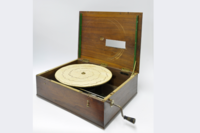Equipment used in the early years of psychology were electro-mechanical instruments for recording external body movements. Many psychologists invented their own instruments to pursue their research.

McDougall-Shuster-Dotter, made by C.F. Palmer, London, around 1900-1934
Invented by McDougall in about 1900 to rate a subject's level of attention and fatigue, this device requires subjects to draw lines connecting, avoiding or circling dots that are presented to them through a window which opens onto a section of a rotating disc of dotted paper. The task is made more or less challenging by adjusting the speed of the rotating disc and the size of the window. The device is a rectangular wood box contains a circular brass plate onto which the "dotting paper" discs are placed. Underneath the brass plate is a gearbox to turn the plate. A crank handle projecting from one side of the wood box winds the gears and a lever above the handle can be pressed to stop and pulled to start the rotation of the disc. On the top of the box is an opening to view the dotting paper. There is a soft metal plate which can be slid over this opening to control the size of the aperture. A fragment of an inch ruler alongside the opening reads "TENTHS MADE IN ENGLAND". A set of about 50 dotting-paper discs were acquired with the instrument. This instrument was used at the Institute of Experimental Psychology c. 1935-1940.

Dual Tracking Task Apparatus, made by C. F. Palmer, London, c. 1920 or earlier
This mechanical instrument was used in psychology laboratories to study eye-hand coordination. It is a wood box containing gearwork that controls three small moving platforms which are visible through a arc-shaped opening in the top of the box. One of these platforms can be moved by a brass knob slider on the top of the box, and another can be moved by turning an aluminum dial also on top of the box. A section at the front of the box opens on hinges to reveal the gearwork and a setting marked "SLOW FAST". There is a black lacquered dial at the front of the box for winding the gearwork and, next to this, another small pull lever. This instrument was used at the Institute of Experimental Psychology (IEP), University of Oxford c. 1948.